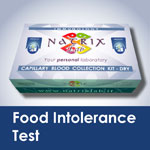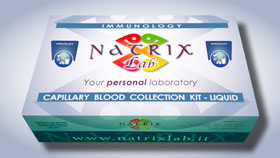What is it and what is it used for?
The Gluten Sensitivity Test determines the presence of gluten sensitivity markers, in particular:
- IgA total
- IgA or IgG Anti-Transglutaminase to exclude a possible celiac diagnosis
- IgA and IgG Anti-Gliadin confirm possible gluten sensitivity
This is one of the first tests able to evaluate non-celiac gluten sensitivity, a disorder affecting people who suffer from intestinal and general disorders due to gluten intake, but who do not have celiac disease and are not allergic to wheat.
Gluten sensitivity often occurs in people who suffer from an irritable colon and intestinal inflammation, because it is easier for food that has not been completely digested to come into contact with the immune barrier and trigger off an inflammatory response.
Who should take the test of gluten sensitivity?

It is estimated that 6-8% of the population are gluten sensitive, and it is a chronic condition that is shown with intestinal or general symptoms of varying intensity, related to an intake of gluten.
This sensitivity is generally associated with the appearance of anti-gliadin antibodies (IgA and IgG anti-AGA), a molecule present in gluten, a protein compound found in wheat, spelt, rye, kamut®, barley and other cereals.
Unlike celiac disease, where ingesting gluten damages the intestinal mucous until the villi atrophies, leading to poor absorption, the symptoms of gluten sensitivity are more obvious from bad reactions to food, the so-called “delayed allergies”, or better known as but improperly called “food intolerances”.
You should take the test if you have one or more of these symptoms when you eat food containing gluten:
- Chronic fatigue, difficulty in concentrating and sleeping
- Digestive difficulty, bloated stomach, sense of nausea, stomach pain and cramps
- Gastric hyperacidity, gastritis
- Diarrhoea, constipation, irregular bowel movements.
- Flatulence, aerophagy.
The most common general symptoms are:
- Hives, acne, dermatitis
- Asthma, cough, hoarseness, excess mucous.
- Altered arterial pressure, palpitations.
- Libido disorders, urogenital inflammation
- Cramp, muscular tremors, weak muscles, joint and muscle pain.
Where and how take the test of gluten sensitivity?
The test involves analysing a blood sample, and can be requested in analysis laboratories, medical centres, health spas and pharmacies that offer NatrixLab diagnosis services.
Preparing for the test: fast for 8 hours beforehand, and it is important to take the test at a time when you are still eating food containing gluten.
…and afterwards?
The only effective treatment to relieve or improve these symptoms, is to follow a specific diet protocol.
A correct diet not only rapidly eliminates the problems (the symptoms recede already in the first month), but it also helps prevent other allergies or sensitivity developing, or even evolving further to become celiac disease.
In order to assist here, NatrixLab has developed specific food protocols that enable eliminating gluten from your diet without running risk of deficiency of those necessary nutritive substances you need: please contact us if you wish for more information.
Repeating the test
We recommend repeating the test after 6-8 months. For treatment monitoring, the test should be repeated when your doctor recommends.
Related tests
Related tests
Food Intolerance Test

The Food Intolerance Test (F.I.T.) is an immune-enzymatic intolerance test against 46, 92 and 184 foods, using the standardised ELISA method, which enables identifying the food protein the organism reacts adversely to.
Find out more
In Flora Scan

“In Flora Scan” is a complete test that is useful to evaluate the flora, any inflammation in the intestine, digestive capacity and intestinal permeability.
Find out more
Cellular Aging Factors

The “Cellular Aging Factors” determine the cell aging profile by means of analysing specific biomarkers, which assess the state of four key processes in the organism: methylation, inflammation, glycation and oxidation.
Find out more
Lipidomic Profile

The “Lipidomic Profile” is a test that systematically identifies the lipids, commonly known as fats, and their structural and functional nature in both physiological and pathological situations.
Find out more
Bibliography
- Caio G, Volta U, Tovoli F, De Giorgio R. Effect of gluten free diet on immune response to gliadin in patients with non-celiac gluten sensitivity.BMC Gastroenterol. 2014 Feb 13;14:26.
- Catassi C, Bai JC, Bonaz B, Bouma G, Calabrò A, Carroccio A, Castillejo G, Ciacci C, Cristofori F, Dolinsek J, Francavilla R, Elli L, Green P, Holtmeier W, Koehler P, Koletzko S, Meinhold C, Sanders D, Schumann M, Schuppan D, Ullrich R, Vécsei A, Volta U, Zevallos V, Sapone A, Fasano A. Non-Celiac Gluten sensitivity: the new frontier of gluten related disorders. Nutrients. 2013 Sep 26;5(10):3839-53. Review.
- Volta U, Bardella MT, Calabrò A, Troncone R, Corazza GR; Study Group for Non-Celiac Gluten Sensitivity. An Italian prospective multicenter survey on patients suspected of having non-celiac gluten sensitivity.BMC Med. 2014 May 23;12:85.
- Sapone A, Bai JC, Ciacci C, Dolinsek J, Green PH, Hadjivassiliou M, Kaukinen K, Rostami K, Sanders DS, Schumann M, Ullrich R, Villalta D, Volta U, Catassi C, Fasano A. Spectrum of gluten-related disorders: consensus on new nomenclature and classification. BMC Med. 2012 Feb 7;10:13.
- Sapone A, Lammers KM, Casolaro V, Cammarota M, Giuliano MT, De Rosa M, Stefanile R, Mazzarella G, Tolone C, Russo MI, Esposito P, Ferraraccio F, Cartenì M, Riegler G, de Magistris L, Fasano A. Divergence of gut permeability and mucosal immune gene expression in two gluten-associated conditions: celiac disease and gluten sensitivity. BMC Med. 2011 Mar 9;9:23.
- Giacomo Caio, Umberto Volta, Francesco Tovoli, Roberto De Giorgio. Effect of gluten free diet on immune response to gliadin in patients with non-celiac gluten sensitivity. BMC Gastroenterol. 2014; 14: 26. Published online 2014 February 13.
 NatrixLab Laboratorio di analisi – nutrizionista
NatrixLab Laboratorio di analisi – nutrizionista

